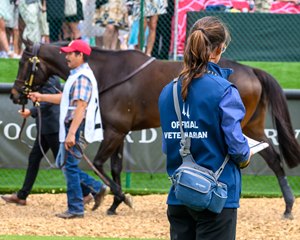HISA: No Single Explanation for Churchill Fatalities


A Horseracing Integrity and Safety Authority investigation into a dozen equine fatalities this spring at Churchill Downs yielded no singular explanation for the incidents, according to a report released Sept. 12 by HISA. But the "absence of a singular explanation underscores the urgent need for further action and analysis to mitigate risk stemming from several factors potentially contributing to equine fatalities," the organization said in a statement about its report.
HISA's investigation evaluated three primary factors: 1) the potential role of Churchill Downs' racetrack surfaces in the breakdowns, 2) veterinary records including the necropsies of each of the 12 horses, and 3) any potential rules violations or procedural deficiencies that may have contributed to the fatalities.
The report of the investigation, which can be viewed online, concluded: "There was no causal relationship between the racetrack surface at Churchill Downs and the equine fatalities. Similarly, there was not a clear pattern in medical histories or injury profiles across the fatalities that point to a single, causal explanation for the fatalities. Nor were there any medication violations present. However, analysis of training histories did indicate an increased risk profile for some of the horses due to the frequency and cadence of their exercise and racing schedules. HISA has shared recommendations on track surface testing and maintenance with Churchill Downs and offers additional procedural improvements for the tracking and reporting of injuries to better inform the development of additional rules."
The release of HISA's findings comes more than three months after the Churchill Downs spring meet was moved to Ellis Park in Western Kentucky in alignment with a recommendation from HISA so that Churchill Downs, the Kentucky Horse Racing Commission, and HISA could review safety and surface protocols and integrity measures in collaboration with industry experts. The Churchill Downs at Ellis Park meet, as well as the traditional Ellis Park summer season, were completed under safer and more typical conditions. Churchill Downs Inc. owns Ellis Park.
While racing shifted to Ellis, horses continued to train at Churchill through the spring and summer. The suspension of racing was made to allow a deeper dive into the track conditions at Churchill analysis that would have caused challenges with ongoing racing, HISA CEO Lisa Lazarus said.
HISA's findings come two days before Churchill Downs is to begin its next meet Sept. 14.
The HISA report mirrors preliminary findings from the HISA, the KHRC, and Churchill Downs, which similarly could not identify specific causes for the fatalities.
Officials have long said that spikes in breakdowns, such as one that occurred at Santa Anita Park in early 2019 or this summer at Saratoga Race Course, are typically multifactorial in nature. The fatalities at Saratoga came under the regulatory oversight of HISA, which did not initiate action to suspend or move that meet. HISA announced in late August an expanded review of the circumstances surrounding recent equine fatalities there, though findings have not yet been released.
"This is for certain an all-hands-on-deck moment," Lazarus said in a press conference that followed the release of Tuesday's report. "There's no one stakeholder group that's responsible for the fatalities, so no one stakeholder group to take the responsibility for solving the issue. This is something that we have to do together as an industry and move forward. And because of HISA, we now have sort of one national regulator that can work with all the industry constituents to essentially achieve these goals and essentially work towards the different initiatives that we've laid out.
"Horses dying is not OK. No one really thinks it's OK. And we are going to do better as an industry, and I think we've made a very significant step forward today."

The fatalities at Churchill Downs occurred on the dirt track and turf course, in racing and during training. One accident occurred in the paddock. At least three of the equine fatalities are not breakdowns—the paddock accident and two sudden deaths during or shortly after races on the turf course.
HISA Racetrack Safety Committee chair Dr. Susan Stover studied the fatalities relative to a control group and noted that statistical data showed that the injured horses had more races per year in their career and more frequent high-intensity exercise. Those factors are "consistent with current knowledge of repetitive, overuse (fatigue) injuries in racehorses," she concluded.
HISA officials said Tuesday that tracking fatalities in workouts leads to increased knowledge about equine welfare.
In late May, veterinary officials from HISA, Churchill Downs Inc., and the Kentucky Horse Racing Commission held an emergency veterinary summit. Additionally, track surface experts Dr. Mick Peterson and Dennis Moore examined the track surfaces. Peterson found them consistent with how they had been in past seasons.
Moore issued a series of recommendations for track maintenance at Churchill Downs, which included using a screen to collect rocks within Churchill's dirt track. Some horsemen noted finding rocks on the surface this spring. Churchill Downs believes that a rock picker and other modalities appear to have resolved the issue of rocks on the racetrack, and Moore's recommendation will take place in 2024 if needed.
"Stepping on a large rock certainly could affect the horse's gait, but it's probably not the key factor that ends up in a catastrophic injury," Stover said Tuesday in the press conference when asked by a reporter about their potential to lead to an equine injury. "Basically, catastrophic injuries are related to horses that have a mild subclinical preexisting injury that predisposes them to more severe injury under otherwise completely normal circumstances. So I think the rock issue has been dealt with and cannot explain the injuries that happened to Churchill."
Earlier this year, Churchill Downs modified its racing procedures, such as restricting the number of starts per horse to four during a rolling eight-week period and prohibiting horses beaten by more than 12 lengths in five consecutive starts from racing there until approved by Churchill Downs Inc. equine medical director Dr. Will Farmer to return.
Additionally, the track has placed restrictions on older first-time starters and horses coming off long layoffs that require consultation and approval from either KHRC veterinarians or by Farmer.

One change announced in early June—a suspension to purse payout allocations to every race finisher—is no longer in place. Payments for Kentucky Thoroughbred Development Fund-eligible horses will extend through last place, it was announced in August.
Asked how many fatalities it might take for HISA to recommend a suspension of racing at Churchill Downs this month, Lazarus declined to give a figure, saying they would analyze racing there on a case-by-case basis.
"If we were to see a number of fatalities with no clear explanation, I imagine that we would want to take the same approach and that Churchill Downs would do the same," she said.
Saying that "action must be taken in reaction to what we know and what we do not know, for the welfare of Thoroughbred horses," HISA said its strategic response plan to address equine fatalities across the country calls for the following:
- A robust data analysis effort in which HISA will work with top data analytics companies to explore critical questions facing the sport with the intent to yield new, actionable insights into factors contributing to equine fatalities.
- And the creation of a Blue-Ribbon Committee to work toward the study and ultimate introduction of more synthetic surface options in Thoroughbred racing. Synthetic surfaces are statistically safer than both dirt and turf tracks.
Additionally, HISA called for improved veterinary screening and diagnostic procedures including:
- Making equine positron emission tomography scans more accessible to racetracks across the country. (Churchill Downs and Santa Anita Park are two tracks with PET scanners.)
- Conducting a research study to examine the causes of exercise-associated sudden deaths.
- Further use of wearable technology as an injury-detection tool, such as StrideSAFE.
- An examination of whether there are any other equine fitness tools worthy of investment and deployment.
Stover called the PET scanner "a game changer." In response to concerns of scanning costs and accessibility to a wide horse population, she said, "It's not that we have to PET scan every single horse before it races. So using another screening technique to detect those horses that should be examined with a PET scanner is the key."
Lazarus expressed hope that other stakeholders in the industry can also work to benefit equine safety, mentioning conversations with sales companies.
She also stressed the importance of data collection and analysis, noting that to be examined are statistics tracking the soundness of the breed to evaluate some critiques of Thoroughbreds not being as sturdy as they once were.
"Obviously, what HISA can mandate is limited to what's within our purview," she said. "That doesn't mean that we can't engage in conversations to try to motivate change, if, in fact, the data indicates we need to change."
